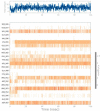Lupenone, a wonder chemical obtained from Euphorbia segetalis to boost affinity for the transcriptional factor escalating drought-tolerance in Solanum Lycopersicum: A cutting-edge computational biology approach
- PMID: 37939107
- PMCID: PMC10631687
- DOI: 10.1371/journal.pone.0281293
Lupenone, a wonder chemical obtained from Euphorbia segetalis to boost affinity for the transcriptional factor escalating drought-tolerance in Solanum Lycopersicum: A cutting-edge computational biology approach
Abstract
Drought is the single greatest abiotic factor influencing crop yield worldwide. Plants remain in one area for extended periods, making them vulnerable to natural and man-made influences. Understanding plant drought responses will help us develop strategies for breeding drought-resistant crops. Large proteome analysis revealed that leaf and root tissue proteins respond to drought differently depending on the plant's genotype. Commonly known as tomatoes, Solanum Lycopersicum is a globally important vegetable crop. However, drought stress is one of the most significant obstacles to tomato production, making the development of cultivars adapted to dry conditions an essential goal of agricultural biotechnology. Breeders have put quite a lot of time and effort into the tomato to increase its productivity, adaptability, and resistance to biotic and abiotic challenges. However, conventional tomato breeding has only improved drought resistance due to the complexity of drought traits. The resilience of tomatoes under drought stress has been the subject of extensive study. Using contemporary sequencing approaches like genomics, transcriptomics, proteomics, and metabolomics has dramatically aided in discovering drought-responsive genes. One of the most prominent families of plant transcription factors, WRKY genes, plays a crucial role in plant growth and development in response to natural and abiotic stimuli. To develop plants that can withstand both biotic and abiotic stress, understanding the relationships between WRKY-proteins (transcription factors) and other proteins and ligands in plant cells is essential. This is despite the fact that tomatoes have a long history of domestication. This research aims to utilize Lupenone, a hormone produced in plant roots in response to stress, to increase drought resistance in plants. Lupenone exhibits a strong affinity for the WRKY protein at -9.64 kcal/mol. Molecular docking and modeling studies show that these polyphenols have a significant role in making Solanum Lycopersicum drought-resistant and improving the quality of its fruit. As a result of climate change, droughts are occurring more frequently and persisting for more extended periods, making it necessary to breed crops resistant to drought. While considerable variability for tolerance exists in wild cousins, little is known about the processes and essential genes influencing drought tolerance in cultivated tomato species.
Copyright: © 2023 Debnath et al. This is an open access article distributed under the terms of the Creative Commons Attribution License, which permits unrestricted use, distribution, and reproduction in any medium, provided the original author and source are credited.
Conflict of interest statement
The authors have declared that no competing interests exist.
Figures







References
-
- Wang J., Sun P.-P., Chen C.-L., Wang Y., Fu X.-Z., and Liu J.-H., "An arginine decarboxylase gene PtADC from Poncirus trifoliata confers abiotic stress tolerance and promotes primary root growth in Arabidopsis," Journal of Experimental Botany, vol. 62, pp. 2899–2914, 2011. doi: 10.1093/jxb/erq463 - DOI - PubMed
-
- Ishiguro S. and Nakamura K., "Characterization of a cDNA encoding a novel DNA-binding protein, SPF1, that recognizes SP8 sequences in the 5′ upstream regions of genes coding for sporamin and β-amylase from sweet potato," Molecular and General Genetics MGG, vol. 244, pp. 563–571, 1994. - PubMed
Publication types
MeSH terms
Substances
LinkOut - more resources
Full Text Sources
Research Materials

